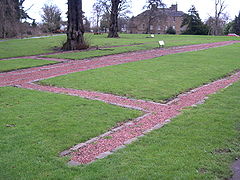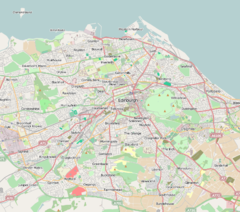- Cramond Roman Fort
-
Coordinates: 55°58′39″N 3°17′48″W / 55.977446°N 3.296687°W
Cramond Roman Fort 
Site of the Roman fort at Cramond
 Cramond Roman Fort shown within Edinburgh
Cramond Roman Fort shown within EdinburghOS grid reference NT1976 List of places: UK • Scotland • Edinburgh Cramond Roman Fort is a Roman-Era archaeological site at Cramond, Edinburgh, Scotland. In the Ravenna Cosmography this settlement is called "Caromago". The fort was established around 140 AD and occupied until around 170, with a further period of occupation from around 208 to 211. Among the many archaeological finds, one of the most famous is a sculpture known as the Cramond Lioness.
Contents
History
The fort at Cramond was located on the River Almond at the point where it flows into the Forth. In Roman times, there was probably a natural harbour here.[1] The Roman fort at Cramond was established around 140 during the building of the Antonine Wall, and remained in use until around 170 when the Romans retreated south to Hadrian's Wall.[2] When the Roman Emperor Septimius Severus began the last major Roman incursion into Scotland from 208 to 211, the fort was reoccupied and enlarged.[2] Throughout these periods of occupation a civilian settlement seems to have existed outside the fort, and some native occupation of the fort seems to have taken place after the time of Severus into the 4th century.[3]
Finds
A stone altar which was dug up a few hundred years ago in the grounds of Cramond House, was originally erected by a cohort of Tungrians (either first or second) and was dedicated to "the Alatervan Mothers and the Mothers of the Parade-ground" (Latin: Matres Alatervae et Matres Campestres).[3] Early antiquarians interpreted this as referring to the place where the stone was found, and drew from it the conclusion that the Roman name of Cramond was "Alaterva".[4] This idea is no longer accepted among scholars, and "Alatervae" is now believed to be an epithet attached to the Matronae, following a practice found elsewhere in the empire.[4] Other stones found at the fort include a centurial stone of Legio II Augusta, and an altar "To Jupiter Optimus Maximus" erected by the fifth cohort of Gauls.[3] In the Ravenna Cosmography this settlement is called "Caromago"[5][6].
The most famous sculpture is the Cramond Lioness recovered from the mouth of the River Almond in 1997. The sculpture, in a non-local white sandstone, shows a lioness devouring her prey, a naked bearded male torso.[7] The sculpture was most probably originally part of a large tomb monument of an important Roman office, perhaps the fort commander or an important dignitary.[7]
The site today
The ground plan of part of the fort is laid out in an area of open parkland. Here one can see headquarters building, granaries, workshop, together with other buildings, restored in outline.[8] Information panels at the site link the findings of the last 50 years of excavations and recreate life in the former Roman headquarters and bathhouse.[9]
References
- ^ T. Christopher Smout, (1992), Scotland and the sea, page 15. Rowman & Littlefield
- ^ a b Cramond Roman Fort at Undiscovered Scotland
- ^ a b c Site Record for Cramond Edinburgh, Cramond Roman Fort Details - Royal Commission on the Ancient and Historical Monuments of Scotland
- ^ a b Proceedings of the Society of Antiquaries of Scotland: Volume 51, page 48. (1917).
- ^ http://www.romanmap.com/htm/ravcosm/rc190,191-200.htm
- ^ http://www.romanmap.com/htm/nomina/Carumabo.htm
- ^ a b Site Record for Edinburgh, Cramond, Cramond Ferry Cramond Ferry Steps; River Almond; 'Cramond Lioness' Details - Royal Commission on the Ancient and Historical Monuments of Scotland
- ^ David John Breeze, (2002), Roman forts in Britain, page 63. Osprey Publishing
- ^ Cramond is turned into next fort of call - news.scotsman.com - 01 May 2004
External links
- Cramond Roman Fort at Undiscovered Scotland
Categories:- History of Edinburgh
- Roman military occupation in southern Scotland
- Roman forts in Scotland
Wikimedia Foundation. 2010.

